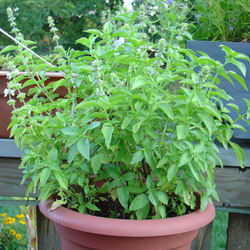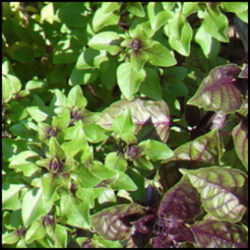In my first DG articles, I wrote about pinching back herbs for use in the kitchen. See "Get the Most from Your Herbs I: Pinch Pinch Pinch, II: Eat What You Pinch, and III: Save Some For Later." If you want to save seeds from your basil to plant next year, however, it's time to let a few plants flower. You can continue to harvest from part of the plant and just let a few stems bloom, if you like.
The blooms of some basil plants, such as Thai Basil ‘Siam Queen' and ‘Magical Michael', are so gorgeous that I rarely pinch them back to prevent flowering. The bees and butterflies are big fans of basil blooms. The bees will pollinate your basil with such enthusiasm that if you're growing different types of basil, you may end up with cross-pollinated seeds.
There are ways to reduce the chances of cross-pollination.  You can isolate your plants in space by putting different basil varieties in different parts of the garden, separating them by 50 or even 100 feet. Or, you can isolate the blooms in time by allowing only one variety of basil to start flowering and setting seed during any given week.
You can isolate your plants in space by putting different basil varieties in different parts of the garden, separating them by 50 or even 100 feet. Or, you can isolate the blooms in time by allowing only one variety of basil to start flowering and setting seed during any given week.
As a practical matter, I generally try to isolate varieties in both space and time. I further hedge my bet by not planting similar varieties next to each other. If I plant a purple basil next to my green lime basil and get a few crossed seeds, the rogues will be easy to see or sniff out in my seedling tray.
 Save seeds from your best, true-to-type plants. If you're growing my favorite Italian pesto basil, and there's one smooth-leafed plant growing among several others with typical puckered leaves, don't harvest seeds from the smooth leafed rogue. You can even improve a strain by saving seeds from only the healthiest, most vigorous, most desirable plants. I've been selectively growing out and saving seeds from the smallest-leafed plants of ‘Minette', ending up with prettier plants each year.
Save seeds from your best, true-to-type plants. If you're growing my favorite Italian pesto basil, and there's one smooth-leafed plant growing among several others with typical puckered leaves, don't harvest seeds from the smooth leafed rogue. You can even improve a strain by saving seeds from only the healthiest, most vigorous, most desirable plants. I've been selectively growing out and saving seeds from the smallest-leafed plants of ‘Minette', ending up with prettier plants each year.
The buds that aren't pinched off will develop into spikes of delicate blooms. As the flowers mature, the petals will drop. The green carpels that remain attached to the bloom stalks contain the developing seeds. These little "pods" dry up and turn brown as the seeds mature.  If you split one open, you can see the developing round seeds inside. As the seed coat hardens, it changes color from pale green to brown to black.
If you split one open, you can see the developing round seeds inside. As the seed coat hardens, it changes color from pale green to brown to black.
 You'll want to stop pinching and start allowing flowering at least 6 weeks before your projected first frost date. Once frost hits a basil plant, it's done. The exact time from bloom to mature seed seems somewhat variable. If I want to be very sure of getting seed from a particular variety, I'll start letting it flower in early August. I've also collected seeds from plants that didn't flower until the end of September, just a few weeks before our first frost.
You'll want to stop pinching and start allowing flowering at least 6 weeks before your projected first frost date. Once frost hits a basil plant, it's done. The exact time from bloom to mature seed seems somewhat variable. If I want to be very sure of getting seed from a particular variety, I'll start letting it flower in early August. I've also collected seeds from plants that didn't flower until the end of September, just a few weeks before our first frost.
If the first frost warning catches you a little too early, try cutting some bloom stalks and putting them in a glass of water inside to finish maturing. If the carpels have at least started changing color, you can usually get some seeds.
When the seeds are ready, you can strip the brown carpels from the bloom stem and crumble them between your fingers to release the seeds. Mature basil seeds are small, round, and black. Separating the seed from the chaff (the dried bits and dust) can be a challenge, but with a little practice you'll find a technique that works for you.
 Dry carpels will drop some seeds if you stir them in a bowl or shake them in a bag. To get more seeds, break them up by crushing them or rubbing them between your fingers. I've tried a few alternatives such as putting them in a bag and using a rolling pin, but I usually end up just doing it by hand. If I put a big pile on a plate or flat bowl, I can get through a lot while watching a movie on TV.
Dry carpels will drop some seeds if you stir them in a bowl or shake them in a bag. To get more seeds, break them up by crushing them or rubbing them between your fingers. I've tried a few alternatives such as putting them in a bag and using a rolling pin, but I usually end up just doing it by hand. If I put a big pile on a plate or flat bowl, I can get through a lot while watching a movie on TV.
I have a couple of sieves that I use next. A coarse sieve separates the larger bits of chaff from the seeds and dusty stuff. Then, a fine sieve lets the dust fall through while the seeds remain behind. At that point, 90% of the chaff should be gone.
 Getting rid of the rest of the chaff is optional, but it leaves the seeds cleaner for storage and makes them look better for trading. The best method I've found for de-chaffing basil and other small seeds is "swirl and blow." I put the seeds and chaff in a shallow bowl and gently blow the chaff away. I tilt the bowl and swirl the contents as I blow, so the heavier seeds end up on one side while the chaff blows away over the opposite edge. Doing this over a tray lets me try again in case I huff and puff too vigorously.
Getting rid of the rest of the chaff is optional, but it leaves the seeds cleaner for storage and makes them look better for trading. The best method I've found for de-chaffing basil and other small seeds is "swirl and blow." I put the seeds and chaff in a shallow bowl and gently blow the chaff away. I tilt the bowl and swirl the contents as I blow, so the heavier seeds end up on one side while the chaff blows away over the opposite edge. Doing this over a tray lets me try again in case I huff and puff too vigorously.
I like to let my seeds sit out another week or two, just to make sure they're completely dry before I put them into labeled zip-top plastic bags. I know I'll have fun trading these seeds over the winter here at DG! Be sure to stop by the Herb Forum as well as the Seed Trading Forum to arrange some fun swaps for your newly harvested basil seed.
Photos by Jill M. Nicolaus.
















